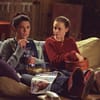Those Gilmore Girls Sure Do Know A Lot About Music
TV’s greatest fast-talking mother and daughter created a discerning but feminine cultural canon, gilded with la-la-las.

“Twenty-five years ago, a show called Gilmore Girls premiered and apparently took the season of fall hostage,” announced Lauren Graham at the Emmys last Sunday. The actress, who played Lorelai Gilmore, stood on a recreation of the Gilmores’ front porch alongside her on-screen daughter Rory (Alexis Bledel), and presented the award for Outstanding Writing in a Comedy Series. She also read my mind: I feel one single chill in the air, or see a slightly crisp leaf, and I know it’s time for a Gilmore Girls rewatch. I’ve seen this series at least 20 times, first when it aired and then on DVD as a teen in the 2000s; I recently started a rewatch with my partner, who hails from near Hartford, Connecticut where the show is set but has never seen it.
There was a level of skepticism at first, the subtext being the usual: How good can this cozy-ass show about a mother and daughter really be? Now, at least once an episode, he’ll find some shot, transition, or structural dichotomy that recalls The Sopranos. We point out the ways its creators, Amy Sherman-Palladino and Daniel Palladino, were clearly influenced by David Lynch; how the quaint utopia of fictional Stars Hollow is like the inverse of “the evil that men do” in the Twin Peaks universe. It’s the level of comparison that Gilmore Girls deserves but rarely receives, for reasons right there in the name: It’s a show about girls… girls who happen to know more about books and movies and music than you do.





